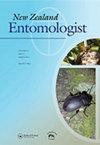民间科学发现,古北毒铁杉蛾(鳞翅目:铁杉科)已在澳大利亚定居
IF 0.4
4区 农林科学
Q4 ENTOMOLOGY
引用次数: 2
摘要
摘要:我们报道了澳大利亚首次发生的毒蛾Agonopterix alstroemeriana(Clerck),这是一种环境杂草Conium maculatum L.(Apiaceae)的单系。同样原产于欧洲的寄主植物是澳大利亚南部常见的有毒杂草,这种蛾可能具有一定的生物防治潜力。它加入了其他古北界物种的名单,这些物种正在向南温带扩张,并可能经由1986年首次建立的新西兰殖民塔斯马尼亚。这一发现得益于智能手机的公民科学应用程序,该应用程序将现场拍摄的动植物图像与众包识别资源联系起来,可以快速得出令人满意的结果。除了它在控制毒铁杉方面的潜在用途外,近150年后,该寄主及其落叶单系的重新结合为昆虫-寄主植物进化理论提供了试验台。本文章由计算机程序翻译,如有差异,请以英文原文为准。
Citizen science reveals the Palaearctic poison hemlock moth Agonopterix alstroemeriana (Clerck) (Lepidoptera: Depressariidae) has established in Australia
ABSTRACT We report the first occurrence in Australia of the poison hemlock moth Agonopterix alstroemeriana (Clerck), a monophage on the environmental weed Conium maculatum L. (Apiaceae). The hostplant, also of European origin, is a familiar toxic weed in southern Australia and the moth may have some potential as a biocontrol agent. It joins a list of other Palaearctic species undergoing range expansion into the southern temperate zone and probably colonised Tasmania via New Zealand where it first established in 1986. The discovery was facilitated by a citizen science application for smart-phones linking images of fauna and flora taken in the field to crowd-sourced identification resources, which can quickly converge to a satisfactory determination. In addition to its potential utility in the control of poison hemlock, the reunion of this host and its defoliating monophage after almost 150 years offers a testbed for theories of insect–hostplant evolution.
求助全文
通过发布文献求助,成功后即可免费获取论文全文。
去求助
来源期刊

New Zealand Entomologist
ENTOMOLOGY-
CiteScore
0.70
自引率
33.30%
发文量
3
审稿时长
>12 weeks
期刊介绍:
The invertebrate diversity of New Zealand is of great interest worldwide because of its geographic isolation and geological history. The New Zealand Entomologist plays an important role in disseminating information on field-based, experimental, and theoretical research.
The New Zealand Entomologist publishes original research papers, review papers and short communications. We welcome submissions in all aspects of science regarding insects and arthropods in a New Zealand or Australasian setting. The journal’s subject matter encompasses taxonomy, phylogenetics, biogeography, biological control and pest management, conservation, ecology and natural history.
The journal is the official publication of the Entomological Society of New Zealand. Papers published or submitted elsewhere for publication will not be considered, but publication of an abstract or summary elsewhere (e.g. conference proceedings) does not preclude full publication in the New Zealand Entomologist. Accepted papers become copyright of the Entomological Society of New Zealand. The journal is published in English, but we also welcome publication of abstracts in Maori.
 求助内容:
求助内容: 应助结果提醒方式:
应助结果提醒方式:


